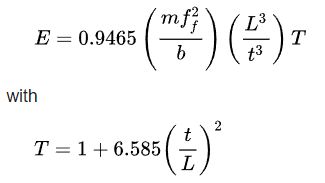|
ff = flexural frequency m = mass b = width L = length t = thickness T = correction factor The correction factor can only be used if L/t ≥ 20! E = Young's modulus |

|
Input units are important.
Input linear dimensions using inches.
Input mass in grams.
Input frequency in Hertz (inverse seconds).
Assume a rectangular bar using width, length, and thickness (inches).
|
ff = flexural frequency m = mass b = width L = length t = thickness T = correction factor The correction factor can only be used if L/t ≥ 20! E = Young's modulus |

|
ASTM E1876-21: Standard Test Method for Dynamic Young's Modulus,
Shear Modulus, and Poisson's Ratio by Impulse Excitation of Vibration
https://en.wikipedia.org/wiki/Impulse_excitation_technique

Elastic Modulia (GPa)
13, lead
68, aluminum annealed
69, aluminum alloy 6061-T6
72, aluminum alloy 7075-t6
110, copper annealed
117-130, copper alloy 110
115, bronze 316
117, brass 360
110, brass 260
179, nickel alloy 400
180, nickel alloy 200
190-210, 1080 steel
193-200, 314 stainless steel
|
For data collection, suggest high- quality directional-microphone, such as the USB Rode Video Mic NTG on a good boom arm, located directly above the sample's end.
For software, Visual Analyzer for PC (free 32-bit) and SpectraPlus-SC (free trial, pay later) have great "peak frequency" meters.
PhyPhox on iPhone and Google give passable results.
Suggest cross-calibrating with tone generators and/or tuning forks.
JQuinn 6/13/2022